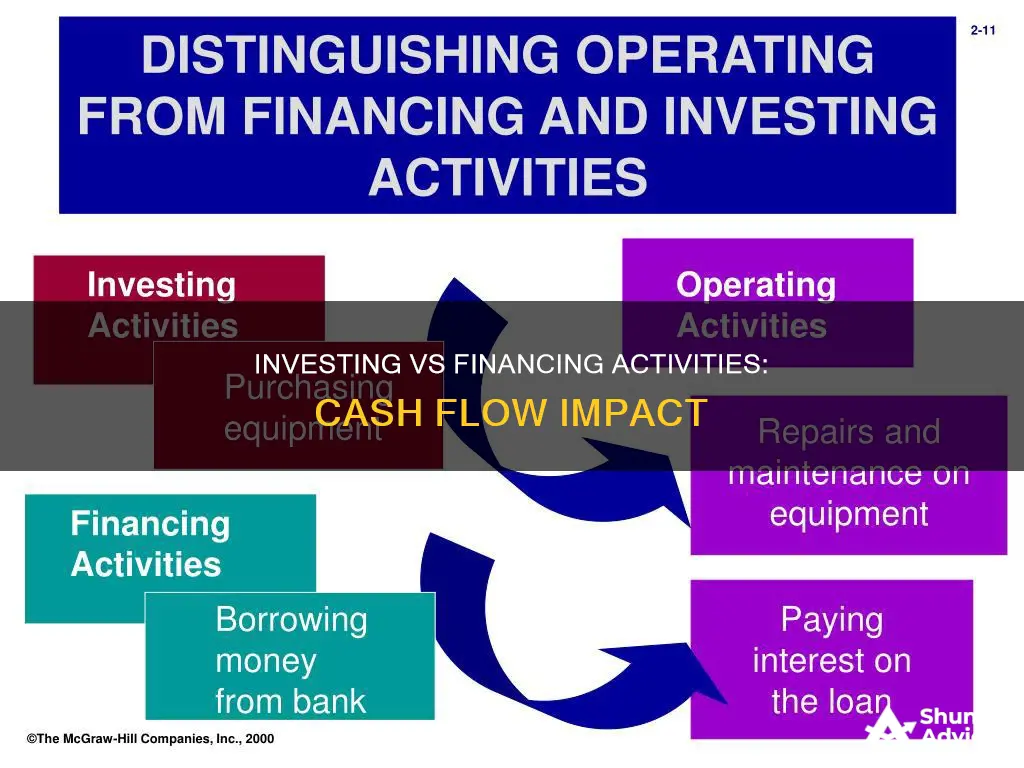
Cash flow is one of the most important components of a company's financial statements. It shows the sources and uses of a company's cash. There are three categories of cash flow statements: cash flow from operations, cash flow from financing activities, and cash flow from investing activities. This paragraph will focus on the latter two.
Cash flow from financing activities (CFF) is a section of a company's cash flow statement that shows the net flow of cash used to fund the company. It includes transactions involving debt, equity, and dividends. Positive CFF indicates that cash has come into the company, increasing its assets, while negative CFF indicates that the company has paid out capital.
Cash flow from investing activities (CFI) is another section of a company's cash flow statement. It reports the cash generated by or spent on investment activities, such as the purchase or sale of physical assets, investments in securities, or acquisitions of other businesses. CFI can be positive (cash generated by sales) or negative (cash spent on long-term assets).
| Characteristics | Values |
|---|---|
| Definition | Cash flow from investing activities (CFI) is a section of a company's cash flow statement that shows how much cash has been generated or spent from various investment-related activities in a specific period. |
| Cash flow from financing activities (CFF) is a section of a company's cash flow statement that shows the net flows of cash used to fund the company. | |
| Types of Activities | Investing activities include purchases of physical assets, investments in securities, or the sale of securities or assets. |
| Financing activities include transactions involving debt, equity, and dividends. | |
| Calculation | CFI is calculated by subtracting total cash outflows from total inflows related to investing activities to find the net cash flow. |
| CFF is calculated by subtracting cash outflows from cash inflows, which come from issuing equity or debt. | |
| Examples | Hershey's net annual cash flow from investing activities for 2023 was -$1,198,676 thousand. |
| Walmart's cash flow from financing activities for the fiscal year ending Jan. 31, 2022, resulted in a net cash flow of -$22.83 billion. |
What You'll Learn
- Cash flow from financing activities provides insight into a company's financial strength
- Investing activities include the purchase of physical assets
- Financing activities include transactions involving debt, equity and dividends
- Cash flow from investing activities reveals a company's investment performance
- Cash flow from investing activities is a section of a company's cash flow statement

Cash flow from financing activities provides insight into a company's financial strength
Cash flow from financing activities is a critical component of a company's financial reporting, offering valuable insights into its financial health and strategic decisions. This section of the cash flow statement outlines the net cash flows used to fund a company's operations, encompassing transactions related to debt, equity, and dividends.
By examining the cash flow from financing activities, investors and analysts can assess a company's financial strength and capital structure management. It provides a window into how well a company is managing its funding sources and whether it is generating sufficient cash to sustain its operations. This analysis is particularly important when evaluating the long-term viability of a company's business model and its ability to meet financial obligations.
The calculation of cash flow from financing activities involves adding cash inflows from issuing debt or equity and subtracting cash outflows from stock repurchases, dividend payments, and debt repayment. A positive cash flow from financing activities indicates that a company is bringing in more money than it is spending, which can signal strong financial performance. However, investors need to be cautious and consider other factors, such as the level of debt the company is carrying.
For example, a company with consistent and substantial operating cash flows demonstrates financial robustness. This is because operating cash flow is generated from regular business activities, indicating a healthy core business. Additionally, a company's ability to generate cash flow from financing activities is crucial for funding investments in fixed assets and equipment, which are necessary for long-term growth.
In summary, cash flow from financing activities is a vital metric for understanding a company's financial strength and strategic decisions. It provides insights into how well a company manages its funding sources and its ability to invest in its business. By analysing this information, investors and analysts can make informed decisions about the company's financial health and future prospects.
Distribution as an Investment: Cash Flow Statement Insights
You may want to see also

Investing activities include the purchase of physical assets
For example, if a business owner invests in a new factory building to expand their operations, this purchase would be considered a cash outflow from investing activities. Similarly, if they sell some old machinery the company no longer needs, the cash received from the sale would be a cash inflow from investing activities.
The purchase of physical assets is an important aspect of growth and capital for a company. This type of investment activity is often a signal of a company that is growing. It can indicate that significant amounts of cash are being invested in the long-term health of the company, such as research and development, which may lead to future growth and gains if those investments are managed well.
The cash flow from investing activities is an important metric for understanding a company's financial health and can provide valuable insights for investors and analysts. It is one of the three main sections of a company's cash flow statement, along with cash flow from operating activities and cash flow from financing activities.
Strategies for Investing Cash Reserves: A Guide to Opportunities
You may want to see also

Financing activities include transactions involving debt, equity and dividends
Financing activities involve transactions relating to long-term liabilities, owner's equity, and short-term debts. This includes the flow of cash and cash equivalents between a company and its sources of finance, such as investors and creditors.
Financing activities are one of the three sections of a company's statement of cash flows, the other two being operating and investing activities. This section of the statement of cash flows shows the net flows of cash used to fund the company, including debt, equity, and dividend transactions.
A company's capital can be sourced from either debt or equity. When a company takes on debt, it usually does so by issuing bonds or taking out a loan from a bank. In both cases, the company must make interest payments to its bondholders and creditors. When a company chooses equity, it issues stock to investors who purchase it for a share in the company. Some companies also make dividend payments to shareholders, representing a cost of equity for the firm.
Financing activities can be categorised as either cash inflows or outflows. A company will have a cash inflow when it receives money from issuing notes payable to creditors or issuing stocks to investors. Conversely, a cash outflow occurs when a company pays off debt or distributes dividends to shareholders.
Examples of cash inflows from financing activities include:
- Issuing bonds
- Sale of treasury stock
- Loan from a financial institution
- Cash from new stock issued
Examples of cash outflows from financing activities include:
- Repayment of existing loans
- Redemption of bonds
- Purchase of treasury stock
- Repurchase of existing stock
- Payment of cash dividends to stockholders
Owner's Investment Cash: Operating Activity?
You may want to see also

Cash flow from investing activities reveals a company's investment performance
Cash flow from investing activities is a critical metric for understanding a company's investment performance and capital allocation decisions. This section of the cash flow statement provides insights into the cash inflows and outflows from investment activities, such as acquiring and disposing of assets, investing in securities, and mergers or acquisitions.
For example, if a company invests in a new factory building, this purchase would be recorded as a cash outflow from investing activities. On the other hand, if the company sells some old machinery, the cash received would be a cash inflow from investing activities. These transactions can have a significant impact on the company's financial position and growth prospects.
By analysing the cash flow from investing activities, stakeholders can assess the company's ability to invest in long-term assets, generate income, and support the overall health of the business. It is important to note that negative cash flow in this section may not always be a negative sign, as it could indicate that the company is investing in its future growth and development.
The cash flow from investing activities is an essential tool for investors, analysts, and company management to evaluate the financial health and investment strategies of a company. It provides a clear picture of how the company allocates its resources and whether it is positioned for growth and long-term success.
In summary, the cash flow from investing activities is a critical aspect of financial statements that reveals a company's investment performance, capital allocation decisions, and overall financial health. It helps stakeholders make informed decisions and assess the company's ability to invest in its future.
Property Investment: All-Cash or Mortgage?
You may want to see also

Cash flow from investing activities is a section of a company's cash flow statement
The cash flow statement is a key financial statement that provides an account of the cash used in operations, including working capital, financing, and investing. It bridges the gap between the income statement and the balance sheet by showing how much cash is generated or spent on operating, investing, and financing activities for a specific period.
Cash flow from investing activities includes the purchase of physical assets, investments in securities, or the sale of securities or assets. These activities can either result in positive or negative cash flow. Purchases require spending money, leading to negative cash flow, while sales produce income, resulting in positive cash flow.
Negative cash flow from investing activities does not necessarily indicate poor financial health. It could mean that the company is investing in assets, research, or other long-term development activities that are crucial for the company's health and continued operations.
Overall, the cash flow statement is an important tool for management, investors, and other stakeholders to understand a company's cash management, short-term solvency, and ability to meet its financial obligations.
Cash Reserves Investments: A Safe Haven for Your Money
You may want to see also
Frequently asked questions
Cash flow from investing activities (CFI) is a section of a company's cash flow statement that reports the cash inflows and outflows resulting from investment activities. These activities primarily involve the acquisition and disposal of long-term assets such as property, plant, equipment, and investments in marketable securities.
Cash flow from financing activities (CFF) is a section of a company's cash flow statement that shows the net flow of cash used to fund the company. Financing activities include transactions involving debt, equity, and dividends.
Investing activities refer to the purchase or sale of long-term assets, such as property, equipment, or investments. On the other hand, financing activities involve transactions related to raising and repaying capital, such as the issuance of equity, dividend payments, receiving loans, and repayment of loans.







